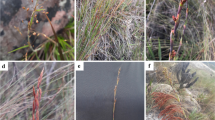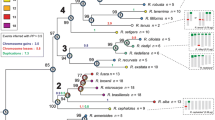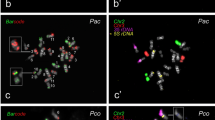Abstract
Despite most of the cytogenetic research is focused on monocentric chromosomes, chromosomes with kinetochoric activity localized in a single centromere, several studies have been centered on holocentric chromosomes which have diffuse kinetochoric activity along the chromosomes. The eukaryotic organisms that present this type of chromosomes have been relatively understudied despite they constitute rather diversified species lineages. On the one hand, holocentric chromosomes may present intrinsic benefits (chromosome mutations such as fissions and fusions are potentially neutral in holocentrics). On the other hand, they present restrictions to the spatial separation of the functions of recombination and segregation during meiotic divisions (functions that may interfere), separation that is found in monocentric chromosomes. In this study, we compare the diversification rates of all known holocentric lineages in animals and plants with their most related monocentric lineages in order to elucidate whether holocentric chromosomes constitute an evolutionary advantage in terms of diversification and species richness. The results showed that null hypothesis of equal mean diversification rates cannot be rejected, leading us to surmise that shifts in diversification rates between holocentric and monocentric lineages might be due to other factors, such as the idiosyncrasy of each lineage or the interplay of evolutionary selections with the benefits of having either monocentric or holocentric chromosomes.



Similar content being viewed by others

Abbreviations
- CenH3:
-
Centromere-specific histone H3 variant
- %GC:
-
Percentage of guanine-cytosine content in the DNA
References
Adilardi RS, Ojanguren-Affilastro AA, Mola LM (2016) Sex-linked chromosome heterozygosity in males of Tityus confluens (Buthidae): a clue about the presence of sex chromosomes in scorpions. PLoS One 11:e0164427. https://doi.org/10.1371/journal.pone.0164427
Albertson DG, Thomson JN (1993) Segregation of holocentric chromosomes at meiosis in the nematode, Caenorhabditis elegans. Chromosom Res 1:15–26. https://doi.org/10.1007/BF00710603
Battaglia E, Boyes JW (1955) Post-reductional meiosis: its mechanism and causes. Caryologia 8:87–134. https://doi.org/10.1080/00087114.1955.10797554
Bigliardo GR, Gabriel Virla E, Caro S, Murillo Dasso S (2011) Karyotype and male pre-reductional meiosis of the sharpshooter Tapajosa rubromarginata (Hemiptera: Cicadellidae). Rev Biol Trop 59:309–314
Blaxter M (2011) Nematodes: the worm and its relatives. PLoS Biol 9:e1001050. https://doi.org/10.1371/journal.pbio.1001050
Bongiorni S, Fiorenzo P, Pippoletti D, Prantera G (2004) Inverted meiosis and meiotic drive in mealybugs. Chromosoma 112:331–341. https://doi.org/10.1007/s00412-004-0278-4
Bureš P, Zedek F, Marková M (2013) Holocentric chromosomes. In: Greilhuber J, Dolezel J, Wendel JF (eds) Plant genome diversity volume 2. Springer, Vienna, pp 187–208
Butlin RK (2005) Recombination and speciation. Mol Ecol 14:2621–2635. https://doi.org/10.1111/j.1365-294X.2005.02617.x
Cabral G, Marques A, Schubert V et al (2014) Chiasmatic and achiasmatic inverted meiosis of plants with holocentric chromosomes. Nat Commun 5:5070. https://doi.org/10.1038/ncomms6070
Chakravorti AK (1948a) Theory of fragmentation of chromosomes and evolution of species. Sci Cult 13:309–312
Chakravorti AK (1948b) Multiplication of chromosome numbers in relation to speciation in Zingiberaceae. Sci Cult 14:137–140
Coghlan A, Eichler EE, Oliver SG et al (2005) Chromosome evolution in eukaryotes: a multi-kingdom perspective. Trends Genet 21:673–682
Colmagro R, Minelli A, Paludetti G, Rasotto MB (1986) Chromosome studies in centipedes (Chilopoda). Caryologia 39:309–323. https://doi.org/10.1080/00087114.1986.10797793
Comings D, Okada T (1972) Holocentric chromosomes in Oncopeltus: kinetochore plates are present in mitosis but absent in meiosis. Chromosoma. https://doi.org/10.1007/BF00284937
Cook LG (2000) Extraordinary and extensive karyotypic variation: a 48-fold range in chromosome number in the gall-inducing scale insect Apiomorpha (Hemiptera: Coccoidea: Eriococcidae). Genome 43:255–263. https://doi.org/10.1139/gen-43-2-255
Costea M, García MA, Stefanović S (2015) A phylogenetically based infrageneric classification of the parasitic plant genus Cuscuta (dodders, Convolvulaceae). Syst Bot 40:269–285. https://doi.org/10.1600/036364415X686567
Davies EW (2010) Cytology, evolution and origin of the aneuploid series in the genus Carex. Hereditas 42:349–365. https://doi.org/10.1111/j.1601-5223.1956.tb03022.x
Demidov D, Schubert V, Kumke K et al (2014) Anti-phosphorylated histone H2AThr120: a universal microscopic marker for centromeric chromatin of mono- and holocentric plant species. Cytogenet Genome Res 143:150–156. https://doi.org/10.1159/000360018
Desai RN, Deshpande SB (1969) Centromere nature of the chromosomes of Ranatra (Heteroptera). Experientia 25:386–387. https://doi.org/10.1007/BF01899937
Dincă V, Lukhtanov VA, Talavera G, Vila R (2011) Unexpected layers of cryptic diversity in wood white Leptidea butterflies. Nat Commun 2:324. https://doi.org/10.1038/ncomms1329
Drinnenberg IA, DeYoung D, Henikoff S, Malik HS (2014) Recurrent loss of CenH3 is associated with independent transitions to holocentricity in insects. elife. https://doi.org/10.7554/eLife.03676
Eroğlu HE, Per S (2016) Karyotype analysis of Zygoribatula cognata (Oudemans) (Acari: Oribatida: Oribatulidae). Turk J Entomol 40:33–38. 10.16970/ted.50556
Escudero M, Hipp AL, Hansen TF et al (2012) Selection and inertia in the evolution of holocentric chromosomes in sedges (Carex, Cyperaceae). New Phytol 195:237–247. https://doi.org/10.1111/j.1469-8137.2012.04137.x
Escudero M, Márquez-Corro JI, Hipp AL (2016) The phylogenetic origins and evolutionary history of holocentric chromosomes. Syst Bot 41:580–585. https://doi.org/10.1600/036364416X692442
Escudero M, Weber JA, Hipp AL (2013) Species coherence in the face of karyotype diversification in holocentric organisms: the case of a cytogenetically variable sedge (Carex scoparia, Cyperaceae). Ann Bot 112:515–526. https://doi.org/10.1093/aob/mct119
Faulkner JS (1972) Chromosome studies on Carex section Acutae in north-west Europe. Bot J Linn Soc 65:271–301. https://doi.org/10.1111/j.1095-8339.1972.tb00120.x
Flach M (1966) Diffuse centromeres in a dicotyledonous plant. Nature 209:1369–1370. https://doi.org/10.1038/2091369b0
Fox J, Weisberg S (2011) An R companion to applied regression, 2nd edn. SAGE, Thousand Oaks
Garcia MA, Costea M, Kuzmina M, Stefanovi S (2014) Phylogeny, character evolution, and biogeography of Cuscuta (dodders; Convolvulaceae) inferred from coding plastid and nuclear sequences. Am J Bot 101:670–690. https://doi.org/10.3732/ajb.1300449
Garrison NL, Rodriguez J, Agnarsson I et al (2016) Spider phylogenomics: untangling the spider tree of life. PeerJ 4:e1719. https://doi.org/10.7717/peerj.1719
Greilhuber J (1995) Chromosomes of the monocotyledons (general aspects). In: Rudall PJ, Cribb PJ, Cutler DF, Humphries CJ (eds) Monocotyledons: systematics and evolution. Royal Botanic Gardens, Kew, pp 379–414
Guerra M, Cabral G, Cuacos M et al (2010) Neocentrics and holokinetics (holocentrics): chromosomes out of the centromeric rules. Cytogenet Genome Res 129:82–96. https://doi.org/10.1159/000314289
Håkansson A (2010) Meiosis and pollen mitosis in X-rayed and untreated spikelets of Eleocharis palustris. Hereditas 40:325–345. https://doi.org/10.1111/j.1601-5223.1954.tb02976.x
Harmon LJ, Weir JT, Brock CD et al (2008) GEIGER: investigating evolutionary radiations. Bioinformatics 24:129–131. https://doi.org/10.1093/bioinformatics/btm538
Heethoff M, Bergmann P, Norton RA (2007) Karyology and sex determination of oribatid mites. Acarologia 46:127–131
Hill CA, Guerrero FD, Van Zee JP et al (2009) The position of repetitive DNA sequence in the southern cattle tick genome permits chromosome identification. Chromosom Res 17:77–89. https://doi.org/10.1007/s10577-008-9003-0
Hipp AL (2007) Nonuniform processes of chromosome evolution in sedges (Carex: Cyperaceae). Evolution 61:2175–2194. https://doi.org/10.1111/j.1558-5646.2007.00183.x
Hipp AL, Escudero M, Chung K-S (2013) Holocentric chromosomes. In: Maloy S, Hughes K (eds) Brenner’s encyclopedia of genetics, 2nd edn. Elsevier, Amsterdam, pp 499–501
Hsu T-W, Kono Y, Chiang T-Y, Peng C-I (2011) Ypsilandra (Melanthiaceae; Liliaceae sensu lato), a new generic record for Taiwan. Bot Stud 52:99–104
Jeffery NW, Oliveira IS, Gregory TR et al (2012) Genome size and chromosome number in velvet worms (Onychophora). Genetica 140:497–504. https://doi.org/10.1007/s10709-013-9698-5
Jeyaprakash A, Hoy MA (2009) First divergence time estimate of spiders, scorpions, mites and ticks (subphylum: Chelicerata) inferred from mitochondrial phylogeny. Exp Appl Acarol 47:1–18. https://doi.org/10.1007/s10493-008-9203-5
Kandul NP, Lukhtanov VA, Pierce NE (2007) Karyotypic diversity and speciation in Agrodiaetus butterflies. Evolution 61:546–559. https://doi.org/10.1111/j.1558-5646.2007.00046.x
Kiauta B, Mol AWM (1977) Behaviour of the spermatocyte chromosomes of the mayfly, Cloeon dipterum (Linnaeus, 1761) s.1. (Ephemeroptera: Baetidae), with a note on the cytology of the order. Genen Phaenen 19:31–39
Kim S-C, Kim JS, Chase MW et al (2016) Molecular phylogenetic relationships of Melanthiaceae (Liliales) based on plastid DNA sequences. Bot J Linn Soc 181:567–584. https://doi.org/10.1111/boj.12405
Kovařík F, Lowe G, Mazuch T et al (2017) Scorpions of the horn of Africa (Arachnida: Scorpiones). Part XI. Pandinurus kmoniceki sp. n. (Scorpionidae) from Somaliland. Euscorpius 2017:1–14
Král J, Kováč L, Št’áhlavský F et al (2008) The first karyotype study in palpigrades, a primitive order of arachnids (Arachnida: Palpigradi). Genetica 134:79–87. https://doi.org/10.1007/s10709-007-9221-y
Král J, Musilová J, Št’áhlavský F et al (2006) Evolution of the karyotype and sex chromosome systems in basal clades of araneomorph spiders (Araneae: Araneomorphae). Chromosom Res 14:859–880. https://doi.org/10.1007/s10577-006-1095-9
Kruschke JK (2013) Bayesian estimation supersedes the t-test. J. Exp. Psychol. 142:573-603. https://doi.org/10.1037/a0029146
Kubitzki K (1998) Thurniaceae. In: Kubitzki K (ed) Flowering plants. Monocotyledons. Alismatanae and Commelinanae (except Gramineae). Springer, Berlin, pp 455–457
Lenormand T, Engelstädter J, Johnston SE et al (2016) Evolutionary mysteries in meiosis. Philos Trans R Soc B Biol Sci 371:20160001. https://doi.org/10.1098/rstb.2016.0001
Luceño M (1993) Chromosome studies on Carex L. section Mitratae Kuekenth. (Cyperaceae) in the Iberian Peninsula. Cytologia 58:321–330. https://doi.org/10.1508/cytologia.58.321
Luceño M, Guerra M (1996) Numerical variations in species exhibiting holocentric chromosomes: a nomenclatural proposal. Caryologia 49:301–309. https://doi.org/10.1080/00087114.1996.10797374
Lukhtanov VA, Kandul NP, Plotkin JB et al (2005) Reinforcement of pre-zygotic isolation and karyotype evolution in Agrodiaetus butterflies. Nature 436:385–389. https://doi.org/10.1038/nature03704
Mahanty HK (1970) A cytological study of the Zingiberales with special reference to their taxonomy. Cytologia 35:13–49. https://doi.org/10.1508/cytologia.35.13
Malheiros N, De Castro D (1947) Chromosome number and behaviour in Luzula purpurea link. Nature 160:156–156. https://doi.org/10.1038/160156a0
Mattos VF, Cella DM, Carvalho LS et al (2013) High chromosome variability and the presence of multivalent associations in buthid scorpions. Chromosom Res 21:121–136. https://doi.org/10.1007/s10577-013-9342-3
Melters DP, Paliulis LV, Korf IF, Chan SWL (2012) Holocentric chromosomes: convergent evolution, meiotic adaptations, and genomic analysis. Chromosom Res 20:579–593
de Almeida BRR, Milhomem-Paixão SSR, Noronha RCR et al (2017) Karyotype diversity and chromosomal organization of repetitive DNA in Tityus obscurus (Scorpiones, Buthidae). BMC Genet 18:35. https://doi.org/10.1186/s12863-017-0494-6
Misof B, Liu S, Meusemann K et al (2014) Phylogenomics resolves the timing and pattern of insect evolution. Science 346(80):763–767. https://doi.org/10.1126/science.1257570
Mola LM (2004) Post-reductional meiosis in Aeshna (Aeshnidae, Odonata). Hereditas 122:47–55. https://doi.org/10.1111/j.1601-5223.1995.00047.x
Mola LM, Papeschi AG (2006) Holocentric chromosomes at a glance. J Basic Appl Genet 17:17–33
Mola LM, Rebagliati PJ, Rodríguez Gil SG, Adilardi RS (2011) Variaciones meióticas y evolución cromosómica en insectos y arácnidos con cromosomas holocinéticos. J Basic Appl Genet 22:12
Monen J, Maddox PS, Hyndman F et al (2005) Differential role of CENP-A in the segregation of holocentric C. elegans chromosomes during meiosis and mitosis. Nat Cell Biol 7:1248–1255. https://doi.org/10.1038/ncb1331
Mora M, Herrera A, León P (1996) The genome of Epiperipatus biolleyi (Peripatidae), a Costa Rican onychophoran. Rev Biol Trop 44:153–157
Murienne J, Daniels SR, Buckley TR et al (2013) A living fossil tale of Pangaean biogeography. Proc R Soc B Biol Sci 281:20132648. https://doi.org/10.1098/rspb.2013.2648
Mutafova T, Dimitrova Y, Komandarev S (1982) The karyotype of four Trichinella species. Z Parasitenkd 67:115–120. https://doi.org/10.1007/BF00929519
Nijalingappa BHM (1975) Cytological studies in Fimbristylis (Cyperaceae). Cytologia 40:177–183. https://doi.org/10.1508/cytologia.40.177
Nokkala S, Kuznetsova VG, Maryanska-Nadachowska A, Nokkala C (2004) Holocentric chromosomes in meiosis. I. Restriction of the number of chiasmata in bivalents. Chromosom Res 12:733–739. https://doi.org/10.1023/B:CHRO.0000045797.74375.70
Nokkala S, Kuznetsova VG, Maryanska-Nadachowska A, Nokkala C (2006) Holocentric chromosomes in meiosis. II. The modes of orientation and segregation of a trivalent. Chromosom Res 14:559–565. https://doi.org/10.1007/s10577-006-1053-6
Ogawa K (1953) Chromosome studies in the Myriapoda. V. A chromosomal survey in some chilopods with a cyto-taxonomic consideration. Jpn J Genet 28:12–18. https://doi.org/10.1266/jjg.28.12
Ogawa K (1955) Chromosome studies in the Myriapoda. IX. The diffuse kinetochore verified by X-ray induced chromosome fragments in Esastigmatobius longitarsis Verhoeff. Zool Mag 64:291–293
Oliveira IS, Franke FA, Hering L et al (2012a) Unexplored character diversity in Onychophora (velvet worms): a comparative study of three peripatid species. PLoS One 7:e51220. https://doi.org/10.1371/journal.pone.0051220
Oliveira IS, Read VM, Mayer G (2012b) A world checklist of Onychophora (velvet worms), with notes on nomenclature and status of names. Zookeys 211:1–70. https://doi.org/10.3897/zookeys.211.3463
Oliver JH (1972) Cytogenetics of ticks (Acari: Ixodoidea). 8. Chromosomes of six species of Egyptian Hyalomma (Ixodidae). J Parasitol 58:611–613
Oliver JH (1977) Cytogenetics of mites and ticks. Annu Rev Entomol 22:407–429
Oliver JH, Tanaka K, Sawada M (1974) Cytogenetics of ticks (Acari: Ixodoidea). Chromosoma 45:445–456. https://doi.org/10.1007/BF00283388
Östergren G (2010) Luzula and the mechanism of chromosome movements. Hereditas 35:445–468. https://doi.org/10.1111/j.1601-5223.1949.tb02884.x
Pazy B, Plitmann U (1995) Chromosome divergence in the genus Cuscuta and its systematic implications. Caryologia 48:173–180. https://doi.org/10.1080/00087114.1995.10797327
R Development Core Team (2016) R: a language and environment for statistical computing. R Foundation for Statistical Computing, Vienna
Roalson EH (2008) A synopsis of chromosome number variation in the Cyperaceae. Bot Rev 74:209–393. https://doi.org/10.1007/s12229-008-9011-y
Rota-Stabelli O, Daley AC, Pisani D (2013) Molecular timetrees reveal a Cambrian colonization of land and a new scenario for Ecdysozoan evolution. Curr Biol 23:392–398. https://doi.org/10.1016/j.cub.2013.01.026
Rowell DM, Higgins AV, Briscoe DA, Tait NN (1995) The use of chromosomal data in the systematics of viviparous onychophorans from Australia (Onychophora: Peripatopsidae). Zool J Linnean Soc 114:139–153. https://doi.org/10.1111/j.1096-3642.1995.tb00117.x
Sauquet H, Doyle JA, Scharaschkin T et al (2003) Phylogenetic analysis of Magnoliales and Myristicaceae based on multiple data sets: implications for character evolution. Bot J Linn Soc 142:125–186. https://doi.org/10.1046/j.1095-8339.2003.00171.x
Schneider MC, Zacaro AA, Pinto-da-Rocha R et al (2009) Complex meiotic configuration of the holocentric chromosomes: the intriguing case of the scorpion Tityus bahiensis. Chromosom Res 17:883–898. https://doi.org/10.1007/s10577-009-9076-4
Shanahan CM (1989a) Cytogenetics of Australian scorpions. I. Interchange polymorphism in the family Buthidae. Genome 32:882–889. https://doi.org/10.1139/g89-525
Shanahan CM (1989b) Cytogenetics of Australian scorpions. II. Chromosome polymorphism in species of Urodacus (family Scorpionidae). Genome 32:890–900. https://doi.org/10.1139/g89-526
Shanahan CM, Hayman DL (1990) Synaptonemal complex formation in male scorpions exhibiting achiasmate meiosis and structural heterozygosity. Genome 33:914–926. https://doi.org/10.1139/g90-138
Sharma PP, Fernandez R, Esposito LA et al (2015) Phylogenomic resolution of scorpions reveals multilevel discordance with morphological phylogenetic signal. Proc R Soc B Biol Sci 282:20142953. https://doi.org/10.1098/rspb.2014.2953
Sheikh SA, Kondo K (1995) Differential staining with orcein, Giemsa, CMA, and DAPI for comparative chromosome study of 12 species of Australian Drosera (Droseraceae). Am J Bot 82:1278–1286. https://doi.org/10.2307/2446251
Sheikh SA, Kondo K, Hoshi Y (1995) Study on diffused centromeric nature of Drosera chromosomes. Cytologia 60:43–47. https://doi.org/10.1508/cytologia.60.43
Shirakawa J, Hoshi Y, Kondo K (2011) Chromosome differentiation and genome organization in carnivorous plant family Droseraceae. Chromosom Bot 6:111–119. https://doi.org/10.3199/iscb.6.111
Shirakawa J, Katsuya N, Yoshikazu H (2011) A chromosome study of two centromere differentiating Drosera species, D. arcturi and D. regia. Caryologia 64:453–463. https://doi.org/10.1080/00087114.2011.10589813
Šmarda P, Bureš P, Horová L et al (2014) Ecological and evolutionary significance of genomic GC content diversity in monocots. Proc Natl Acad Sci 111:E4096–E4102. https://doi.org/10.1073/pnas.1321152111
Soldán T, Putz M (2000) Karyotypes of some Central European mayflies (Ephemeroptera) and their contribution to phylogeny of the order. Acta Soc Zool Bohemicae 64:437–445
Špakulová M, Králová I, Cutillas C (1994) Studies on the karyotype and gametogenesis in Trichuris muris. J Helminthol 68:67–72. https://doi.org/10.1017/S0022149X0001350X
Tamura MN (1998) Melanthiaceae. In: Kubitzki K (ed) Flowering plants. Monocotyledons. Lilianae (except Orchidaceae). Springer, Berlin, pp 369–380
Tanaka N (2003) New status and combinations for Japanese taxa of Chionographis (Melanthiaceae). Novon 13:212–215
Veleba A, Šmarda P, Zedek F et al (2017) Evolution of genome size and genomic GC content in carnivorous holokinetics (Droseraceae). Ann Bot 119:409–416. https://doi.org/10.1093/aob/mcw229
Viera A, Page J, Rufas JS (2009) Inverted meiosis: the true bugs as a model to study. Meiosis 5:137–156. https://doi.org/10.1159/000166639
Wheeler WC, Coddington JA, Crowley LM et al (2016) The spider tree of life: phylogeny of Araneae based on target-gene analyses from an extensive taxon sampling. Cladistics:1–43. https://doi.org/10.1111/cla.12182
Wu L, Tong Y, Yan R-Y, Liu Q-R (2016) Chionographis nanlingensis (Melanthiaceae), a new species from China. Pak J Bot 48:601–606
Acknowledgements
The authors thank the two anonymous reviewers for their helpful comments that helped to improve the previous version of this manuscript and R. Fernández (Harvard University, Cambridge, Massachusetts), G. Giribet (Harvard University, Cambridge, Massachusetts), and J. Rodríguez (Auburn University, Auburn, Alabama) for their help in providing information about the node ages of some lineages. This research was supported by the Spanish Ministry of Economy and Competitiveness (project CGL2016-77401-P).
Conflict of interest
The authors declare that they have no conflict of interest.
Author information
Authors and Affiliations
Corresponding author
Additional information
Responsible Editor: Tatsuo Fukagawa
Electronic supplementary material
ESM 1
(DOCX 1950 kb)
Rights and permissions
About this article
Cite this article
Márquez-Corro, J.I., Escudero, M. & Luceño, M. Do holocentric chromosomes represent an evolutionary advantage? A study of paired analyses of diversification rates of lineages with holocentric chromosomes and their monocentric closest relatives. Chromosome Res 26, 139–152 (2018). https://doi.org/10.1007/s10577-017-9566-8
Received:
Revised:
Accepted:
Published:
Issue Date:
DOI: https://doi.org/10.1007/s10577-017-9566-8



